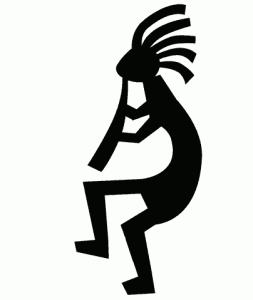Ever since I first presented this post in 2013, it has been viewed countless times. But then, this iconic flute player has a great many fans.
 Writers who, like me, work in genres such as horror and fantasy often mine the rich folklore, myths, and legends of different countries, cultures, ethnic groups and so on to enrich our stories. I thought it might be fun to explore some of the individual entities drawn from these resources, and so I am introducing a new, occasional feature to this blog. And what better character to open this series with than Kokopelli, the “Casanova of the Cliff Dwellers”?
Writers who, like me, work in genres such as horror and fantasy often mine the rich folklore, myths, and legends of different countries, cultures, ethnic groups and so on to enrich our stories. I thought it might be fun to explore some of the individual entities drawn from these resources, and so I am introducing a new, occasional feature to this blog. And what better character to open this series with than Kokopelli, the “Casanova of the Cliff Dwellers”?
Perhaps the most recognizable symbol in all of Native America, and an icon for the indigenous people of the American Southwest, Kokopelli has been around for thousands of years. Also known as the Humpbacked Flute Player, Kokopelli is a Hopi fertility deity. He is also a trickster, a trader, a healer, a rainmaker, and a storyteller. On occasion he is depicted with a wife or consort named Kokopelli Mana, though she is far less known than her illustrious mate. His name might have been derived from the Zuni words for “god” (Koko) and “desert robber fly” (pelli). Regarding the latter, some of the earliest images of Kokopelli on cave paintings has him appearing more like an insect.
 Some say that the hump on Kokopelli’s back is actually a bag in which he carries things, and there are many thoughts on what those contents might be. Perhaps seeds, or songs to accompany his flute playing, or healing medicine, or shells and beads. But first and foremost Kokopelli was a fertility god, and the legends say that he carried babies in his sack to distribute to all of the young women that he seduced. It is said that he would arrive in a village one night, and when he left the next morning, every one of the village’s maidens would be left with a kid. I’m talking a serious stud here! To support this, many early pictographs showed Kokopelli with an enormous penis. You don’t see much of that anymore, because when the Spanish priests came here to Christianize the indigenous people they “persuaded” them to lose the phallus in the name of decency. Hmm, I wonder to what degree they carried that persuasion. (See my post, “California Genocide.”)
Some say that the hump on Kokopelli’s back is actually a bag in which he carries things, and there are many thoughts on what those contents might be. Perhaps seeds, or songs to accompany his flute playing, or healing medicine, or shells and beads. But first and foremost Kokopelli was a fertility god, and the legends say that he carried babies in his sack to distribute to all of the young women that he seduced. It is said that he would arrive in a village one night, and when he left the next morning, every one of the village’s maidens would be left with a kid. I’m talking a serious stud here! To support this, many early pictographs showed Kokopelli with an enormous penis. You don’t see much of that anymore, because when the Spanish priests came here to Christianize the indigenous people they “persuaded” them to lose the phallus in the name of decency. Hmm, I wonder to what degree they carried that persuasion. (See my post, “California Genocide.”)
Knowing what I did about Kokopelli a few decades ago, I used his proclivity for seducing young women in part as a prototype for Montanni, the demon in my horror novel, The Modoc Well. Big difference: Kokopelli always left peacefully, with a big smile on his face, while Montanni—well, like I said, it’s a horror novel.
Other stories have his wife, Kokopelli Mana, chasing after the guys while hubby did his thing with the maidens. And another tale (I love this one!) has Kokopelli detaching his johnson and sending it downriver to get a head start on his activities with the young women who were bathing or washing clothes in the water. Something about that image is going to be stuck in my brain for a while, don’tcha know…
But mostly, Kokopelli is known for a lot of positive things, and his whimsical appearance and good nature accounts for him surviving through millennia as a mythical figure. He seems to bring out smiles in just about everyone that sees him. Maybe, we hope, some of his magical properties will rub off on us.
 With an icon such as Kokopelli, good old American over-commercialism is a given. For many decades now his image has showed up on every product and service imaginable, and in all regions of the country. In 2013 I Googled “Kokopelli” to see what would show up. On the first page, after an entry on Wikipedia, some images, and a wonderful website called Indigenous Peoples Literature I saw Kokopelli Gifts, Kokopelli Western Jewelry, Kokopelli Boutique, Kokopelli Winery, Kokopelli Golf Course (a couple of those), and Kokopelli Art. Sigh…
With an icon such as Kokopelli, good old American over-commercialism is a given. For many decades now his image has showed up on every product and service imaginable, and in all regions of the country. In 2013 I Googled “Kokopelli” to see what would show up. On the first page, after an entry on Wikipedia, some images, and a wonderful website called Indigenous Peoples Literature I saw Kokopelli Gifts, Kokopelli Western Jewelry, Kokopelli Boutique, Kokopelli Winery, Kokopelli Golf Course (a couple of those), and Kokopelli Art. Sigh…
Sure, a great many people have some item depicting Kokopelli, and there is nothing wrong with that. I have more than my share, as you can see. Next to Don Quixote, the “Casanova of the Cliff Dwellers” occupies many corners of our house. But while others may purchase a Kokopelli figurine or shirt because “he’s so cute,” I need to know the story behind the legend. That’s what we writers do; that’s who we are. So hopefully you feel a bit more informed by this brief blog post version.
